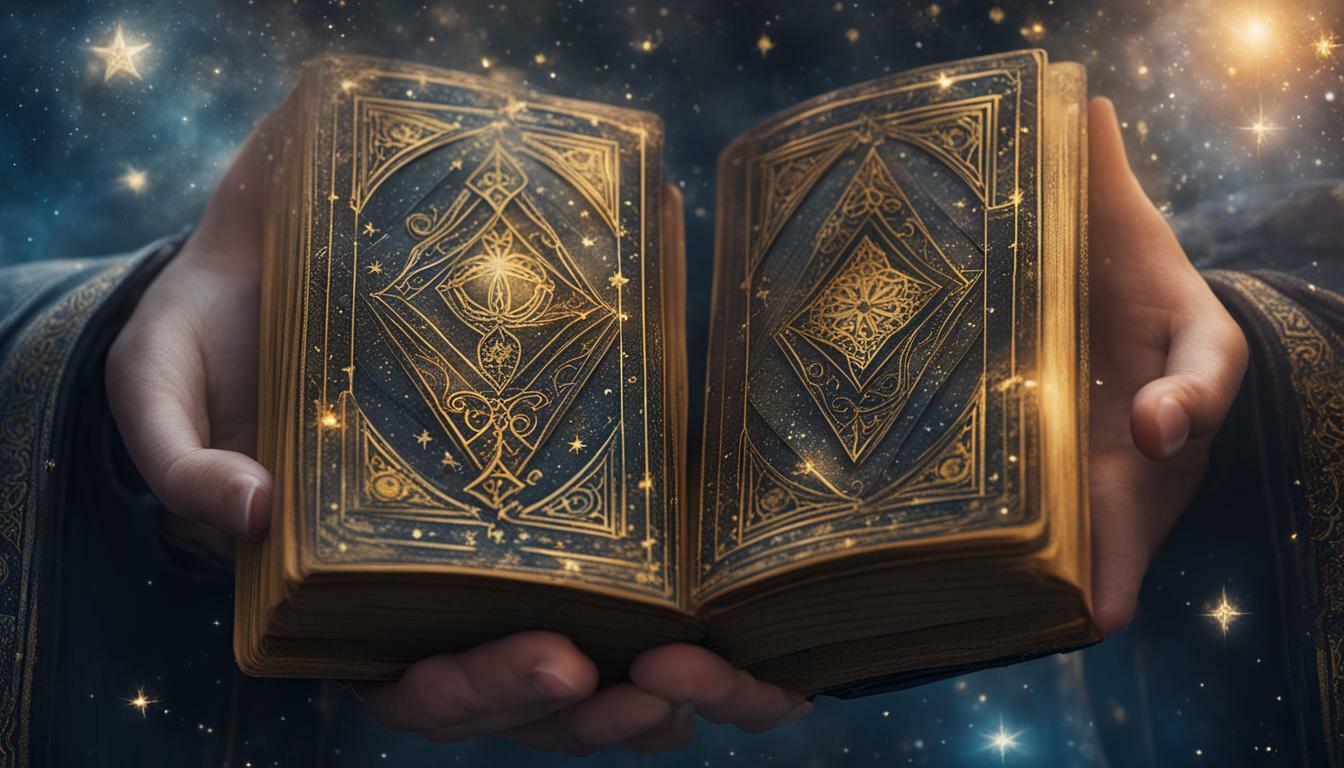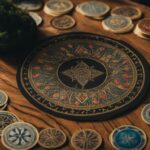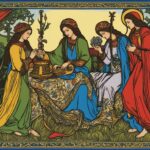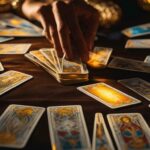Tarot cards have a fascinating history that dates back to the late 14th or early 15th century in Europe. Originally used for a card game called tarocchi, similar to bridge, tarot cards were hand-painted and commissioned by wealthy families as a symbol of their status. Over time, these cards evolved to have deeper meaning and significance, becoming associated with the occult and divination practices.
The earliest known tarot-like cards were created in Italy, such as the Visconti-Sforza deck, which is still preserved today. These early decks included the Major Arcana, a set of 22 cards representing significant life lessons and spiritual themes. Additionally, the Minor Arcana, consisting of four suits, focused on everyday matters and personal experiences.
In the late 18th century, tarot cards gained popularity as tools for divination, and French occultist Jean-Baptiste Alliette published the first definitive guide to tarot card reading during this time. Today, tarot cards are widely used for personal growth, self-reflection, and divination. They have garnered a strong presence in online communities and social media platforms, offering individuals a rich tapestry of symbols and meanings to explore and interpret.
Connecting with a tarot deck that resonates with you is crucial for a meaningful experience. Choosing a deck that speaks to your intuition and personal preferences allows for a more authentic connection and deeper insights. Tarot cards can unlock the secrets of inner wisdom, promoting personal transformation and empowerment.
Key Takeaways:
- Tarot cards originated in Europe during the late 14th or early 15th century.
- They were initially used for a card game called tarocchi and were hand-painted by wealthy families.
- The Visconti-Sforza deck, created in Italy, is one of the earliest known tarot-like decks.
- The Major Arcana represents significant life lessons and spiritual themes.
- The Minor Arcana focuses on everyday matters and personal experiences.
- Tarot cards gained popularity as tools for divination in the late 18th century.
- Jean-Baptiste Alliette published the first definitive guide to tarot card reading.
- Today, tarot cards are widely used for personal growth, self-reflection, and divination.
- Choosing a tarot deck that resonates with you is important for a meaningful connection.
- Tarot cards offer a rich tapestry of symbols and meanings that can unlock inner wisdom.
The Early Origins of Tarot Cards
Tarot cards originated in Europe and were initially used to play a game called tarocchi, similar to bridge. These early versions of tarot cards were hand-painted and commissioned by wealthy families as a symbol of their status. The earliest known tarot-like cards were created in Italy, such as the Visconti-Sforza deck, which is still preserved today. These decks were intricately designed and showcased the artistic talent of the time.
During the 15th century, tarot decks began to include the Major Arcana, which consists of 22 cards representing significant life lessons and spiritual themes. This addition elevated the purpose of tarot cards beyond mere gaming and allowed for deeper introspection and contemplation. The Major Arcana cards explore universal concepts and archetypes, offering insights into the human experience and the mysteries of the world.
In addition to the Major Arcana, tarot decks also developed the Minor Arcana, consisting of four suits: Cups, Pentacles, Swords, and Wands. The Minor Arcana focuses on everyday matters and personal experiences, providing guidance and understanding in areas such as emotions, finances, conflicts, and ambitions. This expansion of tarot decks allowed for a more comprehensive exploration of life’s complexities.
As time went on, tarot cards became associated with the occult and divination practices. In the late 18th century, French occultist Jean-Baptiste Alliette, also known as Etteilla, published the first definitive guide to tarot card reading. This guide, titled “Book of Thoth,” popularized the idea of using tarot cards as tools for self-reflection, spiritual growth, and divination. Alliette’s work significantly influenced the perception and usage of tarot cards, paving the way for their continued relevance and popularity today.
| Origin | Significance |
|---|---|
| Europe, late 14th or early 15th century | Initially used for playing tarocchi, an early form of bridge, and later developed into a tool for self-reflection, divination, and spiritual growth. |
| Italy | Birthplace of early tarot decks, such as the Visconti-Sforza deck, which featured the Major Arcana and showcased artistic talent. |
| 18th century | French occultist Jean-Baptiste Alliette published the first definitive guide to tarot card reading, solidifying their usage in divination practices. |
Today, tarot cards continue to captivate people worldwide. They are widely used as tools for personal growth, self-reflection, and divination. Online communities and social media platforms have further popularized tarot cards, allowing individuals to connect, learn, and share their experiences. The art of tarot card reading requires interpretation and intuition, and choosing a tarot deck that resonates with the individual is important for establishing a meaningful connection. Tarot cards offer a rich tapestry of symbols and meanings that can unlock the secrets of inner wisdom and promote personal transformation and empowerment.
The Visconti-Sforza Deck and the Major Arcana
One of the earliest known tarot-like cards is the Visconti-Sforza deck, which was created in Italy and still exists today. This deck, commissioned by the Visconti and Sforza families during the 15th century, is a testament to the rich history and artistry of tarot cards. It consists of 78 cards, including the Major Arcana, which holds great significance in the tarot deck.
The Major Arcana: Unlocking Spiritual Themes and Life Lessons
The Major Arcana, also known as the “trump cards,” represents powerful archetypal symbols and spiritual themes. These 22 cards serve as a guide to life’s journey, offering profound insights and guidance. Each card in the Major Arcana carries its own unique symbolism and meaning, reflecting the universal experiences and lessons we encounter throughout our lives.
“The Major Arcana holds the keys to unlocking your inner wisdom and understanding the deeper aspects of yourself and the world around you.”
From the Fool’s journey of innocence and spontaneity to the World’s completion and fulfillment, the Major Arcana takes you on a transformative path of self-discovery. These cards encompass both light and shadow aspects of our existence, reminding us that life’s challenges and triumphs are intertwined.
Table: Major Arcana Cards
| Card | Name | Symbolism |
|---|---|---|
| 0 | The Fool | Beginnings, spontaneity, innocence |
| 1 | The Magician | Manifestation, personal power, resourcefulness |
| 2 | The High Priestess | Intuition, divine feminine, subconscious mind |
| … | … | … |
The Visconti-Sforza deck and the Major Arcana cards carry the essence of tarot’s origins. They provide a profound tool for self-reflection, spiritual growth, and divination, offering timeless wisdom and guidance to those who seek it.
The Development of the Minor Arcana
In addition to the Major Arcana, tarot decks also included the Minor Arcana, which focused on everyday matters and personal experiences. The Minor Arcana is divided into four suits: Cups, Pentacles, Swords, and Wands. Each suit represents a different aspect of life and is associated with specific elemental energies.
Here is a breakdown of the four suits and their meanings:
- Cups: Representing emotions, relationships, and creativity, the Cups suit is associated with the element of water. It reflects matters of the heart, intuition, and the realm of feelings.
- Pentacles: The Pentacles suit relates to the material world, including finances, career, and practical matters. It symbolizes abundance, wealth, and the element of earth.
- Swords: Associated with the element of air, the Swords suit represents thoughts, communication, and challenges. It delves into intellectual pursuits, decision-making, and conflicts.
- Wands: The Wands suit embodies action, passion, and creativity. It symbolizes the element of fire and is associated with personal growth, inspiration, and energy.
The Minor Arcana cards in each suit consist of numbered cards from Ace to Ten, as well as four court cards: Page, Knight, Queen, and King. These cards provide specific insights into different situations and offer guidance on how to navigate life’s challenges and opportunities.
Unlocking the secrets of the Minor Arcana
Interpreting the Minor Arcana requires understanding the symbolism and inherent meanings associated with each card. For example, the Ace of Cups signifies new emotional beginnings, love, and deep connections, while the Ten of Pentacles represents fulfillment, family, and financial stability.
“The Minor Arcana acts as a mirror reflecting our day-to-day experiences and emotions,” says renowned tarot expert, Lisa Smith. “By exploring the messages within these cards, we gain valuable insights into our personal journey and can make informed choices.”
Whether used for self-reflection, divination, or personal growth, the Minor Arcana provides a window into the intricate tapestry of our lives, helping us navigate the ebb and flow of everyday existence with clarity and wisdom.
| Symbol | Suit | Element | Meaning |
|---|---|---|---|
| Cups | Water | Emotions, relationships, creativity | |
| Pentacles | Earth | Finances, career, practical matters | |
| Swords | Air | Thoughts, communication, challenges | |
| Wands | Fire | Action, passion, creativity |
Tarot Cards and the Occult
Tarot cards gained association with the occult and divination practices in the late 18th century. The mysterious symbolism and imagery of the cards intrigued occultists, who saw them as a powerful tool for accessing hidden knowledge and communicating with the divine. The tarot’s archetypal images seemed to tap into a collective unconscious, offering insights into the human psyche and the spiritual realms.
The occultist tradition surrounding tarot cards was further popularized by French occultist Jean-Baptiste Alliette, also known as Etteilla. In the late 18th century, Alliette published the first definitive guide to tarot card reading, giving birth to the modern practice of divination with tarot. He introduced the concept of using the cards for fortune-telling and developed his own interpretations of the symbols and meanings within the deck.
Today, tarot cards remain deeply connected to the occult and are used by individuals seeking guidance and self-discovery. Tarot readers employ various spreads and layouts to interpret the cards and uncover insights into their personal lives, relationships, and spiritual journeys. The cards act as a mirror, reflecting the seeker’s subconscious thoughts and emotions, and providing guidance and clarity on their path.
Unlocking the Power of Tarot Cards
As you explore the realm of tarot, it is essential to remember that the true power lies within you. The cards are simply tools that illuminate the depths of your own intuition and wisdom. For a meaningful connection, it is important to choose a tarot deck that resonates with you on a profound level. Look for imagery and symbolism that speaks to your soul, as each deck carries its own energy and personality.
When conducting a tarot reading, trust your intuition and allow the cards to guide you. Embrace the process of interpretation, recognizing that the meanings of the cards are not set in stone but rather fluid and open to personal understanding. Be receptive to the messages that surface, even if they may not align with your expectations. Tarot cards offer a rich tapestry of symbols and meanings that can unlock the secrets of your inner wisdom and promote personal transformation and empowerment.
| Tarot Cards and the Occult | Summary |
|---|---|
| Tarot cards gained association with the occult in the late 18th century | Mysterious symbolism and imagery tapped into hidden knowledge |
| Jean-Baptiste Alliette popularized the occultist tradition surrounding tarot cards | Published the first definitive guide to tarot card reading |
| Tarot cards are used for divination and self-discovery today | Act as a mirror, reflecting the seeker’s subconscious thoughts and emotions |
| Choose a tarot deck that resonates with you on a profound level | Trust your intuition and allow the cards to guide you |
Jean-Baptiste Alliette and Tarot Card Reading
French occultist Jean-Baptiste Alliette played a significant role in popularizing tarot card reading with his influential guide. This guide, titled “Etteilla, ou L’Art de lire dans les Cartes” (Etteilla, or The Art of Reading Cards), was published in the late 18th century and became a cornerstone in the history of tarot interpretation.
Alliette, also known as Etteilla, believed that tarot cards held the key to unlocking hidden knowledge and could provide insights into the past, present, and future. He developed a system of divination that incorporated astrology, numerology, and symbolism to interpret the cards and their meanings.
Etteilla’s guide was a departure from the traditional tarot decks of the time, as he redesigned the cards to include his own interpretations and correspondences. He also introduced the concept of reversed card meanings, believing that the orientation of the cards could add depth and nuance to the readings.
Etteilla’s Influence and Legacy
Etteilla’s guide became immensely popular and sparked a wave of interest in tarot card reading throughout Europe. His work laid the foundation for modern tarot interpretation and influenced subsequent tarot practitioners and scholars.
| Key Contributions of Jean-Baptiste Alliette |
|---|
| Introduced the concept of reversed card meanings |
| Developed a system of divination incorporating astrology, numerology, and symbolism |
| Popularized tarot card reading through his influential guide |
Today, Alliette’s legacy lives on as tarot card reading continues to captivate individuals seeking guidance, self-reflection, and personal growth. The symbolism and meanings of the cards, as interpreted by Alliette and other tarot practitioners, offer a rich tapestry of wisdom and insight that can unlock the secrets of the subconscious mind and empower individuals to make informed decisions about their lives.
Whether you’re a skeptic or a believer, exploring the world of tarot card reading can be a fascinating journey of self-discovery. So why not dive into the realm of the tarot and see what secrets it holds for you?
| Key Takeaways |
|---|
| Jean-Baptiste Alliette popularized tarot card reading with his influential guide |
| Alliette introduced reversed card meanings and a system of divination |
| Tarot card reading offers insights, self-reflection, and personal growth |
The Power and Significance of Tarot Cards Today
Today, tarot cards are widely used as tools for personal growth, self-reflection, and divination, and have gained popularity through online communities and social media platforms. The intricate symbolism and archetypal imagery of tarot cards offer a unique language for exploring the depths of the human psyche and connecting with the spiritual realm.
The tarot deck consists of 78 cards, divided into the Major Arcana and Minor Arcana. The Major Arcana represents significant life lessons and spiritual themes, while the Minor Arcana delves into everyday matters and personal experiences. Each card carries its own symbolism and meaning, allowing for deep introspection and guidance.
One of the fascinating aspects of tarot cards is their versatility. They can be used for meditation, self-reflection, and personal development. Drawing a card daily can provide insights and guidance for navigating life’s challenges and opportunities. Tarot readings, whether performed by oneself or by a professional reader, can help shed light on current situations, offer guidance for decision-making, and provide a framework for self-exploration.
The Evolution of Tarot Decks
Over time, tarot decks have evolved, and countless variations exist today. Each deck carries its own energy and artistic style, allowing individuals to find a deck that resonates with their unique personality and spiritual journey. With the rise of the internet and social media, tarot has become more accessible than ever. Online forums and communities provide spaces for enthusiasts to share insights, ask questions, and deepen their understanding of tarot symbolism.
| Deck Name | Author/Illustrator | Description |
|---|---|---|
| Rider-Waite-Smith Tarot | Pamela Colman Smith, Arthur Edward Waite | A classic deck with detailed illustrations and universal symbolism. |
| Aleister Crowley Thoth Tarot | Aleister Crowley, Lady Frieda Harris | A deck with vibrant artwork and esoteric symbolism. |
| Wild Unknown Tarot | Kim Krans | A modern deck with minimalist black-and-white illustrations, focusing on nature and intuitive connections. |
Whether used as a tool for personal growth, divination, or a combination of both, tarot cards continue to captivate and inspire individuals on their spiritual journeys. With their rich symbolism and profound insights, tarot cards offer a pathway to self-discovery, empowerment, and a deeper understanding of the mysteries of life.
Conclusion
Tarot cards offer a rich tapestry of symbols and meanings that can unlock the secrets of inner wisdom and promote personal transformation and empowerment. Originating in Europe during the late 14th or early 15th century, tarot cards were initially used for the game of tarocchi and were hand-painted by wealthy families as a symbol of their status. The earliest known tarot-like cards, such as the Visconti-Sforza deck, showcased the Major Arcana, representing significant life lessons and spiritual themes. The Minor Arcana, focusing on everyday matters and personal experiences, was also included.
Over time, tarot decks became associated with the occult and divination practices, and French occultist Jean-Baptiste Alliette published the first definitive guide to tarot card reading in the late 18th century. Today, tarot cards have gained popularity as tools for personal growth, self-reflection, and divination. Online communities and social media platforms have contributed to the widespread use of tarot cards, enabling individuals to explore their inner selves and seek guidance from the cards.
When diving into the art of tarot reading, interpretation and intuition play vital roles. Choosing a tarot deck that resonates with you is crucial for establishing a meaningful connection. The unique symbols and meanings on each card create a language that speaks to the subconscious, allowing for profound insights and self-discovery. Tarot cards hold the power to unlock hidden wisdom, reveal paths to personal transformation, and empower individuals on their journey towards self-fulfillment.
What is the History of Tarot Cards?
The history of tarot cards begins in the 15th century, with their roots in playing cards in Europe. Originally used for leisure activities, they evolved into a divination tool by the late 18th century. Tarot cards gained popularity in occultist circles and were linked to mystical beliefs and fortune-telling. Today, they continue to fascinate people seeking insights into their personal lives and spiritual journeys.
FAQ
Q: How did tarot cards begin?
A: Tarot cards originated in Europe during the late 14th or early 15th century as playing cards for the game tarocchi. They were commissioned by wealthy families as a symbol of their status and were hand-painted. Eventually, tarot decks evolved to be associated with the occult and divination practices.
Q: What is the historical origin of tarot cards?
A: Tarot cards have ancient origins and can be traced back to Italy, where the earliest known tarot-like cards were created, such as the Visconti-Sforza deck. This deck is still preserved today and included the Major Arcana, a set of 22 cards representing significant life lessons and spiritual themes.
Q: What is the significance of the Visconti-Sforza deck and the Major Arcana?
A: The Visconti-Sforza deck is one of the earliest tarot decks and holds historical importance. The Major Arcana in this deck represents profound life lessons and spiritual themes, providing a rich tapestry of symbols and meanings for interpretation and personal growth.
Q: How did the Minor Arcana develop?
A: The Minor Arcana, consisting of four suits, was later added to tarot decks to focus on everyday matters and personal experiences. These suits include wands, cups, swords, and pentacles, and offer insights into various aspects of life and human experiences.
Q: How did tarot cards become associated with the occult?
A: Tarot cards gained association with the occult in the late 18th century. Their symbolism and mystical allure made them popular among occultists, who saw them as tools for divination and spiritual exploration.
Q: Who was Jean-Baptiste Alliette and what did he contribute to tarot card reading?
A: Jean-Baptiste Alliette, a French occultist, published the first definitive guide to tarot card reading in the late 18th century. His work, known as “Etteilla,” provided interpretations and spreads for tarot cards, shaping the practice of tarot card reading as we know it today.
Q: How are tarot cards used today?
A: Tarot cards are widely used as tools for personal growth, self-reflection, and divination. Many people turn to tarot readings for guidance and insights into various aspects of life. The availability of tarot decks online and through social media platforms has contributed to their popularity and accessibility.








